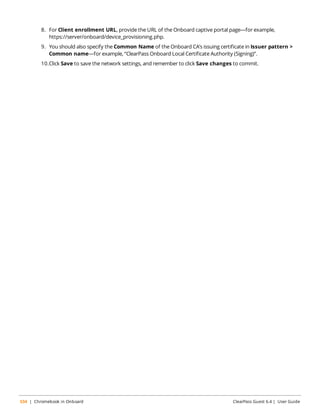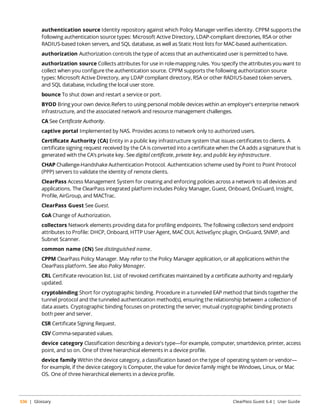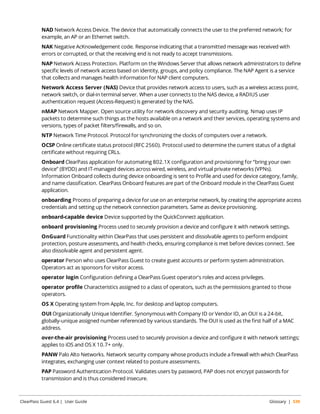This document is the user guide for ClearPass Guest 6.4. It provides an overview of ClearPass Guest functionality and features for visitor management, device provisioning, and customizing the guest portal. The guide covers topics such as guest self-registration, device registration, digital passes, advertising services, and system administration. It is intended to help users understand and utilize the various ClearPass Guest modules.
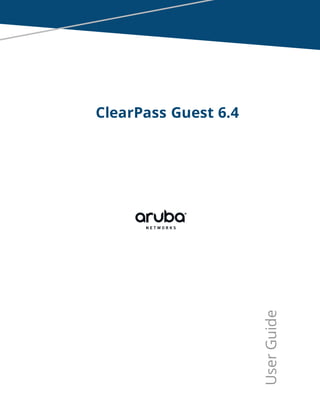








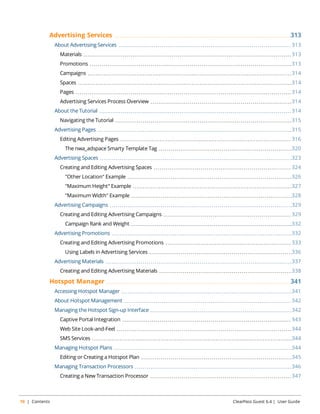






![Chapter 1
About this Guide
ClearPass Guest provides a simple and personalized user interface through which operational staff can quickly
and securely manager visitor network access.
Audience
This User Guide is intended for system administrators and people who are installing and configuring ClearPass
Guest as their visitor management solution. It describes the installation and configuration process.
Conventions
The following conventions are used throughout this guide to emphasize important concepts:
Table 1: Typographical Conventions
Type Style Description
Italics This style is used to emphasize important terms and to mark the titles of books.
System items This fixed-width font depicts the following:
l Sample screen output
l System prompts
l Filenames, software devices, and specific commands when mentioned in the text
Commands In the command examples, this bold font depicts text that you must type exactly as
shown.
<Arguments> In the command examples, italicized text within angle brackets represents items that
you should replace with information appropriate to your specific situation. For example:
# send <text message>
In this example, you would type “send” at the system prompt exactly as shown, followed
by the text of the message you wish to send. Do not type the angle brackets.
[Optional] Command examples enclosed in brackets are optional. Do not type the brackets.
{Item A |
Item B}
In the command examples, items within curled braces and separated by a vertical bar
represent the available choices. Enter only one choice. Do not type the braces or bars.
The following informational icons are used throughout this guide:
Indicates helpful suggestions, pertinent information, and important things to remember.
Indicates a risk of damage to your hardware or loss of data.
Indicates a risk of personal injury or death.
ClearPass Guest 6.4 | User Guide About this Guide | 17](https://image.slidesharecdn.com/clearpassguest6-140929110332-phpapp02/85/ClearPass-Guest-6-4-User-Guide-17-320.jpg)





![AAA Framework
ClearPass Guest is built on the industry standard AAA framework, which consists of authentication,
authorization, and accounting components.
The following figure shows how the different components of this framework are employed in a guest access
scenario.
Figure 4 Sequence diagram for network access using AAA
In the standard AAA framework, network access is provided to a user according to the following process:
l The user connects to the network by associating with a local access point [1].
l A landing page is displayed to the user [2] which allows them to log in to the NAS [3], [4] using the login
name and password of their guest account.
l The NAS authenticates the user with the RADIUS protocol [5].
l ClearPass Policy Manager determines whether the user is authorized, and, if so, returns vendor-specific
attributes [6] that are used to configure the NAS based on the user’s role and other policies [7].
l If the user’s access is granted, the NAS permits the guest access to the network based on the settings
provided by the ClearPass Policy Manager server.
l The NAS reports details about the user’s session to the ClearPass Policy Manager server using RADIUS
accounting messages [8].
l After the user’s session times out [9], the NAS will return the user to an unauthorized state and finalize the
details of the user’s session with an accounting update [10].
ClearPass Guest 6.4 | User Guide ClearPass Guest Overview | 23](https://image.slidesharecdn.com/clearpassguest6-140929110332-phpapp02/85/ClearPass-Guest-6-4-User-Guide-23-320.jpg)

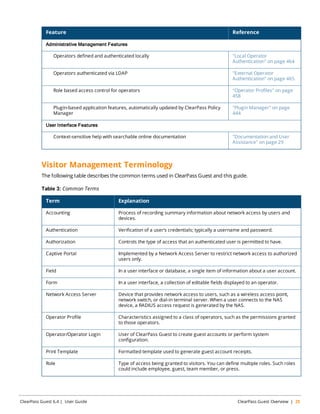









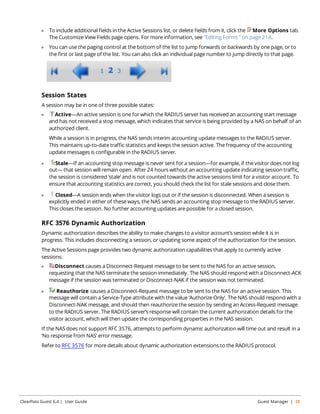















![The Export Accounts view (guest_export) may be customized by adding new fields, or by modifying or
removing the existing fields. See "Customizing Guest Self-Registration" on page 235 for details about this
customization process.
About CSV and TSV Exports
In CSV and TSV format, the following default fields are included in the export:
l Number – Sequential number of the guest account in the exported data
l User ID – Numeric user ID of the guest account
l Username – Username for the guest account
l Role – Role for the guest account
l Activation – Date and time at which the guest account will be activated, or “N/A” if there is no activation
time
l Expiration – Date and time at which the guest account will expire, or “N/A” if there is no expiration time
l Lifetime – The guest account’s lifetime in minutes after login, or 0 if the account lifetime is not set
l Expire Action – Number specifying the action to take when the guest account expires (0 through 4)
About XML Exports
The default XML format consists of a <GuestUsers> element containing a <GuestUser> element for each
exported guest account. The numeric ID of the guest account is provided as the “id” attribute of the
<GuestUser> element. This format is compatible with the ClearPass Policy Manager XML format for guest
users.
The values for both standard and custom fields for guest accounts are exported as the contents of an XML tag,
where the tag has the same name as the guest account field.
An example XML export is given below:
<?xml version="1.0" encoding="UTF-8" standalone="true"?>
<MyContents xmlns="http://www.example.com/myapiDefs/1.0">
<MyHeader version="6.0" exportTime="Sun, 16 Dec 2012 16:36:03 PST"/>
<GuestUsers>
<GuestUser guestType="USER" enabled="true" sponsorName="55480025"
expiryTime="2012-12-04 13:39:25" startTime="1969-12-31 16:00:00"
password="08654361" name="55480025">
<GuestUserTags tagValue="Hotspot Services self-provisioned guest account
Source IP: 10.11.10.254 MAC: unknown Plan: Free Access x 1 Transaction
Amount: $0.00 Invoice Number: P-15 Transaction ID: " tagName="notes"/>
<GuestUserTags tagValue="2" tagName="[Role ID]"/>
<GuestUserTags tagValue="1" tagName="do_expire"/>
<GuestUserTags tagValue="1" tagName="simultaneous_use"/>
ClearPass Guest 6.4 | User Guide Guest Manager | 51](https://image.slidesharecdn.com/clearpassguest6-140929110332-phpapp02/85/ClearPass-Guest-6-4-User-Guide-51-320.jpg)





















![is in effect. (The rule could instead have been written "periodic mon 9am to 5pm shared roles default_role,
other_role" if this was the desired result.)
This example shows how to use an overlapping time range: place the most general time range first, with
more specific time ranges later. In particular, reversing the order of the periodic statements will not work.
Example:
default deny
periodic 9:00 to 22:00 shared roles default_role
no periodic thu 9:00 to 17:00
periodic fri 9:00 to 17:00 not shared
This example shows how to share a device with a basic policy, and demonstrates two ways to disable
sharing for a subset of the time period.
The device will be shared with a single role named default_role, from 9:00 to 22:00 each day. ("periodic
9:00 to 22:00 shared roles default_role").
On Thursday, the device is not shared between 9:00 and 17:00.
On Friday, the device is not shared between 9:00 and 17:00.
Example:
default allow
periodic 9:00 to 22:00 shared roles default_role
no periodic thu 9:00 to 17:00
periodic fri 9:00 to 17:00 not shared
This example is similar to the previous example; the device is not shared on Thursday and Friday between
9:00 and 17:00.
The difference is after 22:00 and before 9:00: in the previous example, the device is not shared during this
time period, whereas with default allow the other AirGroup sharing rules will take effect (any shared users,
roles, groups or locations that have been defined for the device).
Time-Based Syntax Reference
This reference describes the syntax used for time formats in time-based sharing rules. It supplements the
examples for AirGroup time-based sharing by user groups discussed in "AirGroup Time-Based Sharing Syntax
Examples" on page 71. For more information on using time-based sharing with AirGroup, see "About AirGroup
Time-Based Sharing" on page 75.
The syntax for AirGroup time-based sharing policies supports all the default time-based ACL rules specified in
TimeRangeACL. This ACL is a sequence of rules, one per line, according to the following syntax:
l default allow|deny
Specifies the default behavior for unmatched times; this is 'allow' only if no 'periodic' or 'absolute' rules are
specified, otherwise it is 'deny'. Use 'default allow' if the remaining rules exclude times, otherwise use
'default deny' if the remaining rules are to include times. This rule may only be used once.
l [time] zone default|server|...
Specifies the time zone to use for matching times and specifying the time of day. If unset, the current time
zone setting is used (note that this may vary due to operator and/or profile settings). If the value "default"
or "server" is specified, the system's time zone is used. Otherwise, the named time zone is used. This rule
may only be used once, and must be before any rules specifying a time interval.
l [not] period(ic) [day-list] hh:mm to [day] hh:mm
Specifies a periodic or daily interval. Recognized days include Sunday, Monday, Tuesday, Wednesday,
Thursday, Friday, Saturday and 3-letter abbreviations; the tokens "weekends" and "weekdays" may also be
ClearPass Guest 6.4 | User Guide Guest Manager | 73](https://image.slidesharecdn.com/clearpassguest6-140929110332-phpapp02/85/ClearPass-Guest-6-4-User-Guide-73-320.jpg)
![used. Without a day-list, all days of the week are matched. Time may be specified in 12 or 24 hour format,
with the special time 24:00 indicating the end of the day.
Example: periodic monday 8:00 to friday 17:00 matches between 8am and 5pm, Monday through
Friday.
Example: periodic weekdays 8:00 to 17:00 specifies the same thing as the example in the previous line.
Example: periodic wed 11am to 11pm matches between 11:00 and 23:00 on a Wednesday.
Example: periodic weekend 0:00 to 24:00 matches any time on a Saturday or Sunday.
Example: periodic saturday sunday 0:00 to 24:00 specifies the same thing as the example in the
previous line.
The 'not' keyword may be specified to invert the allow/deny decision.
Example: default allow; not period 23:00 to 6:00 (on 2 separate lines) allows access, except between
11pm and 6am.
Example: period 6:00 to 23:00 is equivalent to the example in the previous line.
l not before [date-and-time]
Specifies an absolute time before which access will always be rejected.
Example: not before 2010-07-01 09:00 matches after 9am on 1 July 2010.
l not after [date-and-time]
Specifies an absolute time after which access will always be rejected.
Example: not after 2011-01-01 00:00 matches before midnight on New Year's Day 2011.
l [not] abs(olute) [start-date-and-time] to [end-date-and-time]
Specifies a start and end interval. The date and time is a format recognized by strtotime(). Times between
the start and end point are matched. The 'not' keyword may be specified to invert the allow/deny decision.
Example: absolute December 25 to December 26 matches all day on Christmas Day each year. (This does
not match on December 26 as midnight on this date is the endpoint of the interval.)
A blank time ACL means "all times are allowed".
The following examples give common usage:
l 8:00 to 18:00 - allows access 8am to 6pm, every day, but not outside those times
l weekdays 9am to 5pm - allows access 9am to 5pm, Monday through Friday, but not outside those times
l weekdays 9am to 5pm
weekends 10am to 4pm - allows access 9am to 5pm, Monday through Friday, with reduced hours on
Saturday and Sunday
Annual recurrences may be specified:
l weekdays 9am to 5pm
not absolute December 25 to December 26 - allows access 9am to 5pm, Monday through Friday, but not
on Christmas Day
Less common cases:
l default allow
not 23:00 to 6:00 - allows access, except between 11pm and 6am daily
l 9:00 to 18:00
not before 2010-02-01 - allows daily access between 9am and 6pm, starting on February 1, 2010
74 | Guest Manager ClearPass Guest 6.4 | User Guide](https://image.slidesharecdn.com/clearpassguest6-140929110332-phpapp02/85/ClearPass-Guest-6-4-User-Guide-74-320.jpg)












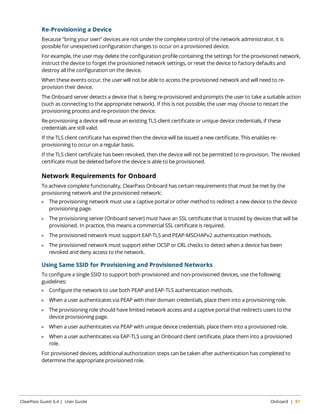


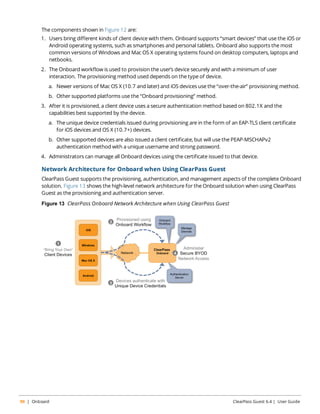

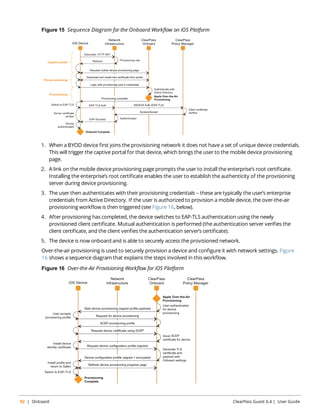










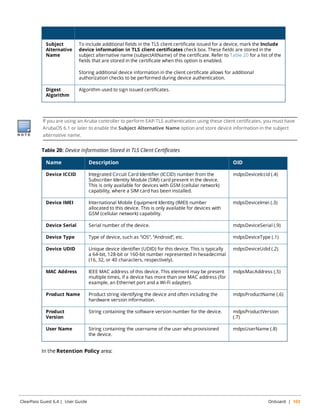



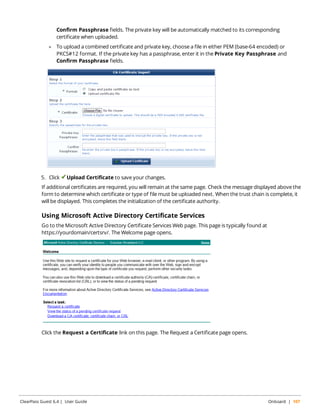


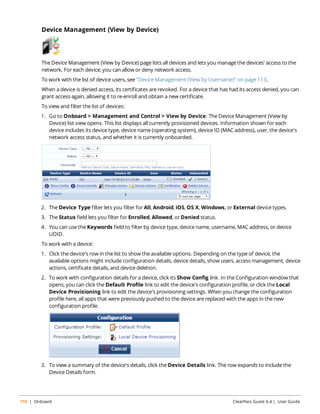




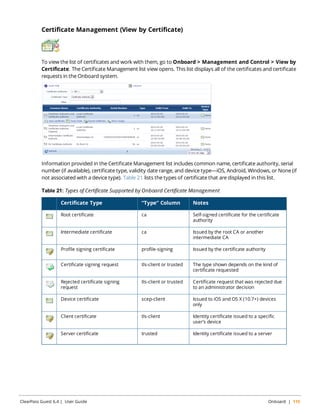



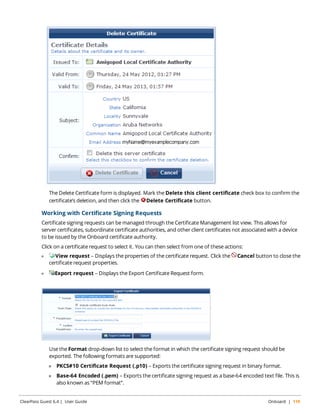







































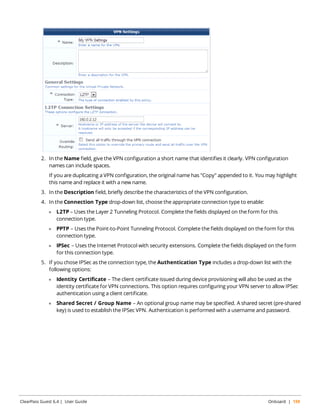
































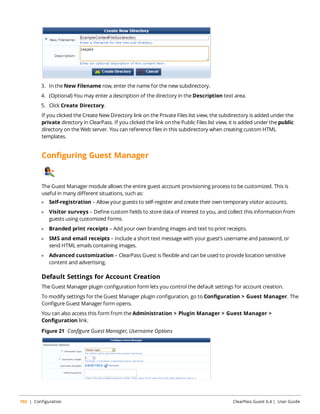

![Field Description
contain different combinations of uppercase letters, lowercase letters, digits and symbols (!#$%&()
*+,-./:;<=>?@[]^_{|}~,). The available options for this setting are:
l No password complexity requirement
l At least one uppercase and one lowercase letter
l At least one digit
l At least one letter and one digit
l At least one of each: uppercase letter, lowercase letter, digit
l At least one symbol
l At least one of each: uppercase letter, lowercase letter, digit, and symbol
Minimum
Password
Length
The minimum acceptable password length for guests changing their account passwords. The
original default password length is six characters.
Disallowed
Password
Characters
Special characters that should not be allowed in a guest password. Spaces are not allowed by
default. You can specify special characters, numbers, and letters to exclude from passwords—for
example, letters and numbers that can look similar, such as i, l, 1, 0, O, o, 5, S, 8, B.
Disallowed
Password
Words
(Optional) Enter a comma- separated list of words that are disallowed and will not be created by the
random words password generator.
Password
Example
(Optional) Shows a sample password generated according to the rules specified by the selections in
the Password Type and Password Length fields. You can click the Generate link to view different
examples.
Password
Logging
(Optional) By default, the passwords for created guest accounts are logged in the application log and
may be recovered from there. For increased security, you may prevent this password from being
logged by unselecting this check box.
Password
Display
(Optional) Select the View guest account passwords option to enable the display of visitor account
passwords in the user list. To reveal passwords, the password field must be added to the “guest_
users” or “guest_edit” view, and the operator profile in use must also have the View Passwords
privilege.
Figure 23 Configure Guest Manager, Expiration Options
194 | Configuration ClearPass Guest 6.4 | User Guide](https://image.slidesharecdn.com/clearpassguest6-140929110332-phpapp02/85/ClearPass-Guest-6-4-User-Guide-194-320.jpg)













































![Figure 29 Sequence Diagram for Guest Self-Registration
In this diagram, the stages in the self-registration process are identified by the numbers in brackets, as follows:
The captive portal redirects unauthorized users [1] to the registration page [2]. After submitting the registration
form [3], the guest account is created and the receipt page is displayed [4] with the details of the guest account.
If NAS login is enabled (the default), submitting the form on this page will display a login message [5] and
automatically redirect the guest to the NAS login [6]. After authentication and authorization the guest’s security
profile is applied by the NAS [7], enabling the guest to access the network [8].
Editing Self-Registration Pages
When you edit a registration page, links let you go directly to the section of the Customize Guest Registration
form that corresponds to the stage of the process you want to edit.
To edit a self-registration page, go to Configuration > Pages > Guest Self-Registrations, select the page in
the list, and click its Edit link. The Customize Guest Registration workflow diagram opens.
240 | Configuration ClearPass Guest 6.4 | User Guide](https://image.slidesharecdn.com/clearpassguest6-140929110332-phpapp02/85/ClearPass-Guest-6-4-User-Guide-240-320.jpg)





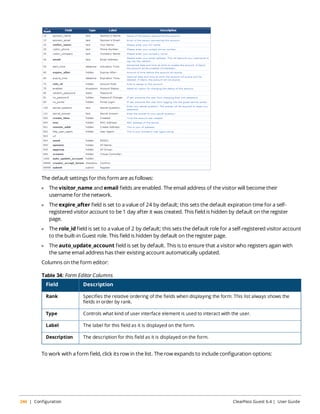



















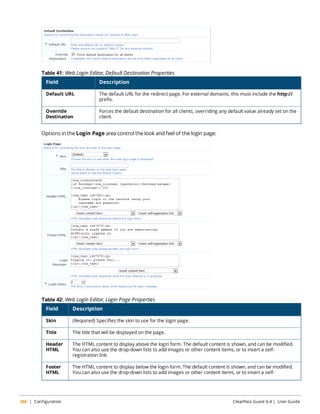














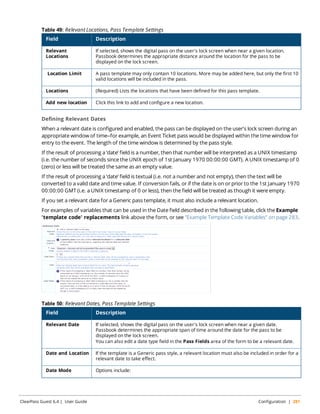






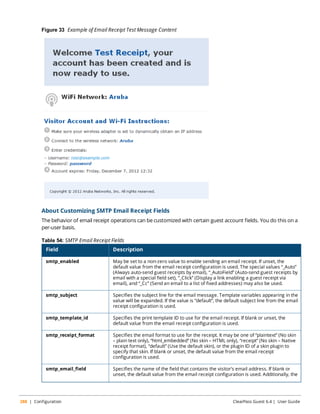


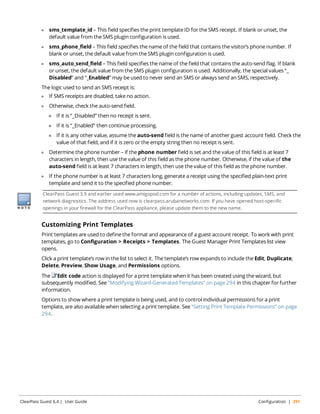




























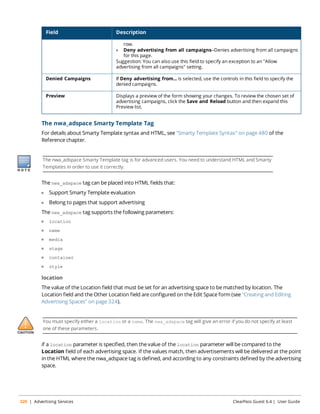




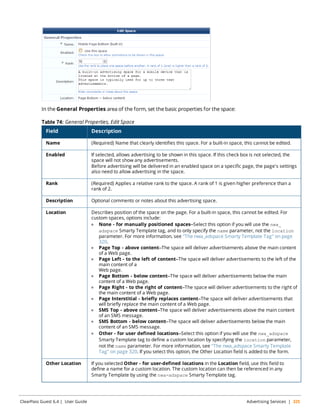


![l Two rows with heights 60 and 40
l Two rows with heights 50 and 50
l One row of height 80
l One row of height 100
"Maximum Width" Example
If a maximum width was specified, the system will only output as many columns as will fit within the maximum
width constraint for the space. For example, with a maximum width constraint of 100 and a maximum
columns constraint of 3, the system could output any of the following:
l Three columns with widths 40, 40, and 20
l Three columns with widths 30, 30, and 30
l Two columns with widths 60 and 40
l Two columns with widths 50 and 50
l One columns of widths 80
l One columns of widths 100
In the Promotional Material Constraints area of the form, set the options that control what can and cannot
be shown in the advertising space:
Table 76: Promotional Material Constraints, Edit Space
Field Description
Allowed
Material
Select each type of promotional material that should be allowed in this space. Types included
are:
l Flash advertisement [Web]
l HTML code (advanced) [Web]
l Image advertisement [Web]
l Text advertisement [Web]
l YouTube video advertisement [Web]
l Text advertisement [SMS]
When you have completed your entries on this form:
l If you are creating a new space, click Create to create the new space and return to the Advertising Spaces
list, or click Create and Reload to create the new space and reload the Edit Space form.
l If you are editing an existing space, click Save to save your changes and return to the Advertising Spaces list,
or click Save and Reload to save your changes and reload the Edit Space form.
328 | Advertising Services ClearPass Guest 6.4 | User Guide](https://image.slidesharecdn.com/clearpassguest6-140929110332-phpapp02/85/ClearPass-Guest-6-4-User-Guide-328-320.jpg)



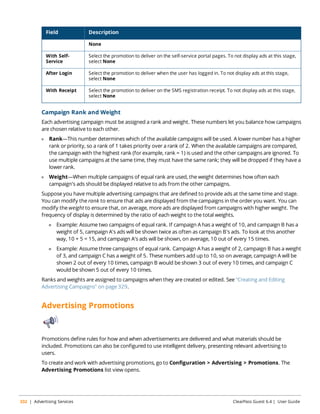





























![Field Description
When a poll is run, you may click Show Details in the Controllers list to view the updated
configuration. For more information, see "AirGroup Controllers" on page 358. Automatic
polling is run only on the publisher node.
Group Names Enter names of shared groups that should be available in the Shared Groups field for users
to choose from when they share a device. If additional user groups are also entered by
users when they share a device, the list in the configuration is automatically updated to
capture these fields. Removing a group name from this list does not remove it from other
shared group lists.
When you type a name for the group in the Group Names field, press the Enter key, and
click Save, the group is created in the system and appears as a "tag". For more information,
see "About AirGroup Time-Based Sharing" on page 75.
Each group name may not exceed 64 characters. A maximum of 32 group names may be
entered. The maximum character limit for the list is 320 characters (including comma
separators).
Network Interface Interface AirGroup will use to send outbound notification messages. To enable using a
virtual IP address, select the appropriate interface. Options include:
l Automatic — Automatically chooses the appropriate source IP address; either the
management port or the data port, depending on the controller's IP address.
l Management port [MGMT] — Always uses the management port as the source
address.
l Data/External port [DATA] — Always uses the data port as the source address.
Timeout Number of seconds after which an attempt to send an AirGroup message will time out.
Attempts Maximum number of times the system should attempt to send an AirGroup message.
AirGroup Logging Choose one of the following options:
l Disabled—Do not log AirGroup related events
l Standard (Recommended)—Log basic information
l Extended—Log additional information
l Debug—Log debug information
l Trace—Log all debug information
See also:
l "AirGroup Diagnostics" on page 362
l "AirGroup Services " on page 358
AirGroup Diagnostics
The AirGroup Diagnostics form lets you perform several diagnostic actions. To access this form, go to
Administration > AirGroup Services > Configuration, and then click the AirGroup Diagnostics link in the
upper-right corner. The AirGroup Diagnostics form opens.
362 | Administration ClearPass Guest 6.4 | User Guide](https://image.slidesharecdn.com/clearpassguest6-140929110332-phpapp02/85/ClearPass-Guest-6-4-User-Guide-362-320.jpg)

















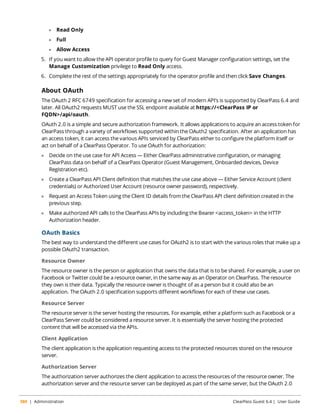







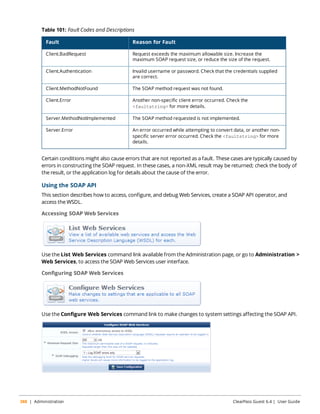








































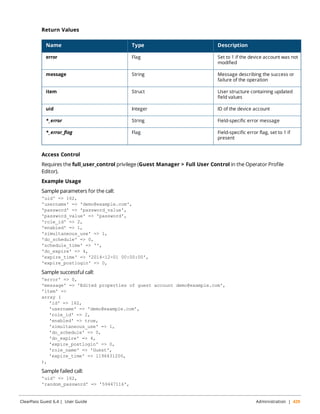




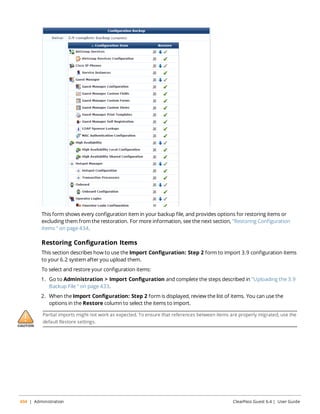

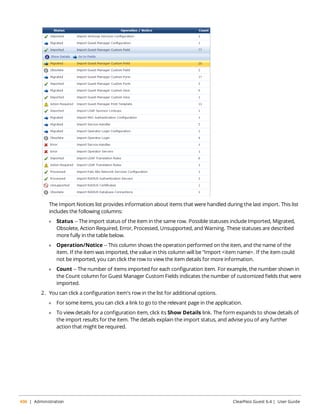




![RADIUS Database Connections
l The RADIUS database connection for the local RADIUS server is obsolete.
l For any custom user databases, an authentication source must be created in CPPM.
RADIUS Database User Accounts
l User accounts are migrated and keep the status (disabled, pending, active, expired) they had in 3.9. Any
field names that differ in 6.2 are updated.
l User accounts with the Deleted status are obsolete.
RADIUS Dictionary
l The RADIUS dictionary is unsupported.
RADIUS NAS List
l Each RADIUS network access server (NAS) is imported as a CPPM network access device (NAD) client.
RADIUS Server Configuration
l Non-default RADIUS Server Number settings are obsolete.
l Non-default RADIUS Server Port settings are obsolete.
l Default RADIUS Server Options are not applicable; they are processed and ignored.
l For any non-default RADIUS Server Options, an authentication source must be created in CPPM.
l Non-default Case Insensitive Username settings are obsolete.
l Non-default Include Active Sessions settings are obsolete.
l Non-default EAP Server settings are obsolete.
l Non-default AAA Debug settings are obsolete.
l Non-default Extra RADIUS Attributes settings are obsolete.
l Non-default Interim Accounting settings are obsolete.
l RADIUS Server Configuration is imported (and flagged as imported or action required)
RADIUS User Roles
l For any role that does not have the default attributes ( Reply-Message := <?= $role['name'], the role
must be manually configured in CPPM.
l For any role that had MAC caching enabled, the role must be manually configured in CPPM.
RADIUS Web Logins
l RADIUS Web logins are imported.
Import Information: Reporting Manager Definitions
l Reports must be re-created in ClearPass Insight.
ClearPass Guest 6.4 | User Guide Administration | 441](https://image.slidesharecdn.com/clearpassguest6-140929110332-phpapp02/85/ClearPass-Guest-6-4-User-Guide-441-320.jpg)

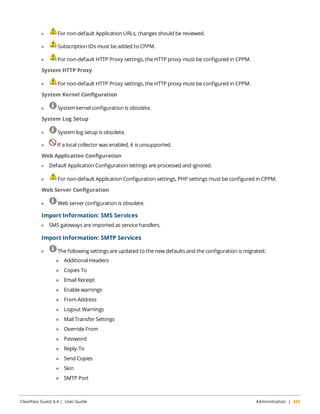































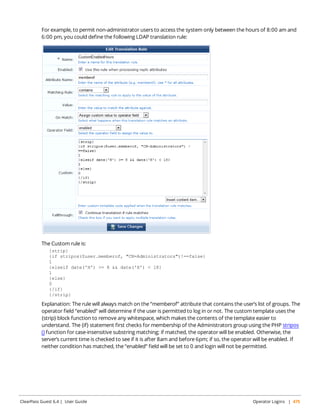



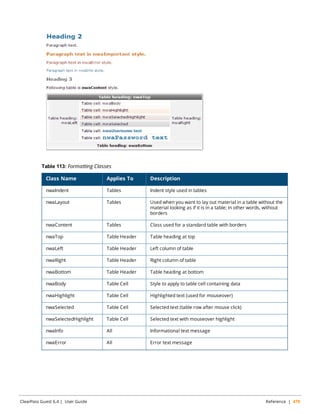

![Conditional Text Blocks
To include a block of text only if a particular condition is true, use the following syntax:
{if $username != ""}
<tr>
<td class="nwaBody">Username:</td>
<td class="nwaBody">{$username}</td>
</tr>
{else}
<!-- No user name, no table row -->
{/if}
The condition tested in the {if} … {/if} block should be a valid PHP expression. The {else} tag does not require
a closing tag.
Script Blocks
The brace characters { and } are specially handled by the Smarty template engine. Using text that contains
these characters, such as CSS and JavaScript blocks, requires a Smarty block {literal} … {/literal}:
<script type="text/javascript" language="JavaScript">
{literal}
<!--
function my_function() {
// some Javascript code here
} // -->
{/literal}
</script>
Failing to include the {literal} tag will result in a Smarty syntax error when using your template. Single
instances of a { or } character can be replaced with the Smarty syntax {ldelim} and {rdelim} respectively.
Repeated Text Blocks
To repeat a block of text for each item in a collection, use the {section} … {/section} tag:
{section loop=$collection name=i}
<tr>
<td class="nwaBody">
{$collection[i].name}
</td>
</tr>
{sectionelse}
<!-- included if $collection is empty -->
{/section}
The content after a {sectionelse} tag is included only if the {section} block would otherwise be empty.
Foreach Text Blocks
An easier to use alternative to the {section} … {/section} tag is to use the {foreach} … {/foreach} block:
{foreach key=key_var item=item_var from=$collection}
{$key_var} = {$item_var}
{foreachelse}
<!—included if $collection is empty -->
{/foreach}
The advantage of this syntax is that each item in the collection is immediately available as the named item
variable, in this example {$item_var}. This construct is also useful when iterating through associative arrays
indexed by key, as the key is immediately available with each item.
ClearPass Guest 6.4 | User Guide Reference | 481](https://image.slidesharecdn.com/clearpassguest6-140929110332-phpapp02/85/ClearPass-Guest-6-4-User-Guide-481-320.jpg)







![Calculate the number of sessions for accounting records matching a specific IP address. The IP address
attribute is looked up automatically from the RADIUS Access-Request (Framed-IP-Address attribute).
See "GetTraffic()" on page 490 for details on how to specify the time interval.
See "GetIpAddressTraffic()" on page 489 for additional details on the $ip_addr argument.
GetIpAddressTime()
GetIpAddressTime($ip_addr, $from_time = null, $to_time = null)
Calculate sum of session times in a specified time interval. The IP address is looked up automatically from the
RADIUS Access-Request (Framed-IP-Address attribute).
See "GetTraffic()" on page 490 for details on how to specify the time interval.
See "GetIpAddressTraffic()" on page 489 for additional details on the $ip_addr argument.
GetIpAddressTraffic()
GetIpAddressTraffic($ip_addr, $from_time = null, $to_time = null, $in_out = null)
Calculate sum of traffic counters in a time interval. The IP address used is determined based on the context. If
processing a RADIUS Access-Request, the IP address is determined using the Framed-IP-Address attribute. If
processing a HTTP request, the current client IP address is assumed
(from $_SERVER['REMOTE_ADDR']).
Specifying an empty value for the IP address (such as null, false, or empty string) also causes the current client
IP address to be used.
See "GetTraffic()" on page 490 for details on how to specify the time interval.
GetSessions()
GetSessions($criteria, $from_time, $to_time = null)
Calculate the number of sessions from accounting records in the database.
This is a multi-purpose function that has a very flexible query interface. For ease of use, consider using one of the
related functions "GetCallingStationSessions()" on page 486, "GetIpAddressSessions()" on page 488,
"GetUserActiveSessions()" on page 490, or "GetUserSessions()" on page 491.
$criteria is the criteria on which to search for matching accounting records.
As well as the criteria specified, the time interval specified by $from_time and optionally $to_time is also
used to narrow the search.
If $to_time is not specified, $from_time is a “look back” time, that is, the time interval in seconds before the
current time.
If $to_time is specified, the interval considered is between $from_time and $to_time.
Returns the total number of sessions for matching accounting records in the time interval specified.
GetSessionTimeRemaining()
GetSessionTimeRemaining($username, $format = “relative”)
Calculates the session time remaining for a given user account, if the user account was to be authenticated at
the moment of the call.
The $username parameter is required. This is the username for the authentication.
ClearPass Guest 6.4 | User Guide Reference | 489](https://image.slidesharecdn.com/clearpassguest6-140929110332-phpapp02/85/ClearPass-Guest-6-4-User-Guide-489-320.jpg)

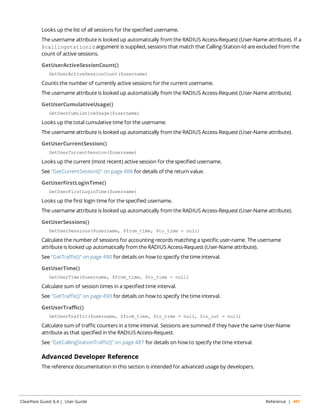
![nwa_assign
{nwa_assign …}
Smarty registered template function. Assigns a page variable based on the output of a generator function.
Simple usage example:
{nwa_assign var=my_variable value=my_value}
l The “var” parameter specifies the page variable that will receive the output.
l The “value” parameter specifies the value to assign to “var”.
The various request variables may also be accessed using one of two supported methods:
l {nwa_assign var=_GET.get_variable value=...}
l {nwa_assign var=smarty.get.get_variable value=...}
The variables that can be accessed this way are _GET (smarty.get), _POST (smarty.post), _REQUEST
(smarty.request), _SESSION (smarty.session), _COOKIE (smarty.cookies), and _ENV (smarty.env).
Assigning to values in _SESSION will persist the value for the next page load in the session.
Alternative usage example:
{nwa_assign var=userskin_plugin generator=NwaGetPluginDetails arg=$u.userskin}
l The “generator” parameter specifies the generator function to be called.
l A single “arg” parameter, if specified, provides a 1-argument form of calling the function; alternatively,
“arg1”, “arg2”, ... may be specified to form an array of arguments to pass to the generator.
nwa_bling
{nwa_bling …}
Smarty registered template function. Adds various kinds of visual effects to the page.
Usage example:
{nwa_bling id=$some_id type=fade}
The “id” parameter is the ID of the HTML element to which you will add ‘bling’ effects The “type” parameter is
the kind of bling desired:
l “fade”: element smoothly fades in and out
l “blink”: element blinks slowly
nwa_makeid
{nwa_makeid …}
Smarty registered template function. Creates a unique identifier and assigns it to a named page variable.
Identifiers are unique for a given page instantiation.
Usage example:
{nwa_makeid var=some_id}
The “var” parameter specifies the page variable that will be assigned.
Alternative usage:
{nwa_makeid var=some_id file=filename}
The “file” parameter specifies a file which contains a unique ID. This allows issued IDs to be unique across
different page loads. To return the value rather than assign it to a variable, use the syntax:
{nwa_makeid [file=filename] output=1}
Otherwise, this template function does not generate any output.
492 | Reference ClearPass Guest 6.4 | User Guide](https://image.slidesharecdn.com/clearpassguest6-140929110332-phpapp02/85/ClearPass-Guest-6-4-User-Guide-492-320.jpg)














![Field Description
this field to 0 to disable this account expiration timer.
http_user_agent String. Identifies the Web browser that you are using. This tracks user’s
browsers when they are registering. This is stored with the user’s account.
id String. Internal user ID used to identify the guest account to the system.
ip_address String. The IP address to assign to stations authenticating with this account. This
field may be up to 20 characters in length. The value of this field is not currently
used by the system. However, a RADIUS user role may be configured to assign
IP addresses using this field by adding the Framed-IP-Address attribute, and
setting the value for the attribute to: <?= $user["ip_address"]
modify_expire_postlogin String Value indicating how to modify the expire_postlogin field.
This field is only of use when editing a visitor account. It may be set to one of the
following values:
l “expire_postlogin” to set the post-login expiration time to the value in the
expire_postlogin field;
l “plus X” or “minus X”, where X is a time measurement, to extend or reduce
the post-login expiration timer by X (minutes, but may have a “ywdhms”
suffix to indicate years, weeks, days, hours, minutes, seconds respectively);
l A number, to set the post-login expiration time to the value specified;
l Any other value to leave expire_postlogin unmodified.
This field controls account modifications; it is not stored with the visitor account.
modify_expire_time String. Value indicating how to modify the expire_time field.
This field may be provided when creating or editing a visitor account. It may be
set to one of the following values:
l “none” to disable the account expiration timer (do_expire and expire_time
will both be set to 0);
l “now” to disable the account immediately;
l “expire_time” to use the expiration time specified in the expire_time field;
l “expire_after” to set the expiration time to the current time, plus the number
of hours in the expire_after field;
l “plus X” or “minus X”, where X is a time measurement, to extend or reduce
the expiration time by X (hours, but may have a “ywdhms” suffix to indicate
years, weeks, days, hours, minutes, seconds respectively);
l A time measurement “X”, to set the expiration time to the current time plus X;
l Any other value to leave expire_time unmodified.
This field controls account creation and modification behavior; it is not stored
with created or modified visitor accounts.
modify_expire_usage String. Value indicating how to modify the expire_usage field. This field is only
of use when editing a visitor account. It may be set to one of the following
values:
l “expire_usage” to set the cumulative usage expiration timer to the value in
the expire_usage field;
l “plus X” or “minus X”, where X is a time measurement, to extend or reduce
the cumulative usage expiration timer by X (seconds, but may have a
“ywdhms” suffix to indicate years, weeks, days, hours, minutes, seconds
respectively);
l A number, to set the cumulative usage expiration time to the value specified;
l Any other value to leave expire_usage unmodified.
This field controls account modifications; it is not stored with the visitor account.
modify_password String. Value indicating how to modify the account password.
l It may be one of the following values:
ClearPass Guest 6.4 | User Guide Reference | 507](https://image.slidesharecdn.com/clearpassguest6-140929110332-phpapp02/85/ClearPass-Guest-6-4-User-Guide-507-320.jpg)
![Field Description
l “random_password” to use the password specified in the random_password
field;
l “reset” to create a new password, using the method specified in the
random_password_method field (or the global defaults, if no value is
available in this field);
l “password” to use the value from the password field;
l Any other value leaves the password unmodified.
This field controls account creation and modification behavior; it is not stored
with created or modified visitor accounts.
modify_schedule_time String. Value indicating how to modify the schedule_time field.
It may be one of the following values:
l “none” to disable the account activation time;
l “now” to activate the account immediately;
l “schedule_time” to use the activation time specified in the schedule_time
form field (normally a UNIX time, but may be 0 to disable activation time);
l “schedule_after” to set the activation time to the current time plus the
number of hours in the schedule_after field;
l “plus X”, where X is a time measurement, to extend the activation time by X.
The time measurement is normally hours, but may have a “ywdhms” suffix to
indicate years, weeks, days, hours, minutes, or seconds, respectively.
Alternatively, this operation may be written equivalently as ‘+X’, ‘pX’, ‘plusX’,
‘add X’, ‘addX’, or ‘aX’. Example: to delay activation time by 2 days, use the
value +2d.
l “minus X”, where X is a time measurement, to reduce the activation time by
X. See above for details about specifying a time measurement. Alternatively,
this operation may be written equivalently as ‘-X’, ‘mX’, ‘minusX’, ‘sub X’,
‘subX’, or ‘sX’. Example: to bring forward activation time by 12 hours, use the
value -12h.
l A time measurement “X”, to set the activation time to the current time plus X.
l A time and date specification, to set the activation time to that time and
date. Many different formats are specified; for clarity it is recommended
that a standard format such as ISO-8601 is used (“YYYY-MM-DD hh:mm:ss”
format).
l Any other value to leave schedule_time unmodified.
This field controls account creation and modification behavior; it is not stored
with created or modified visitor accounts.
multi_initial_sequence Integer. Initial sequence number. This field is used when creating guest
accounts and the random_username_method field is set to “nwa_sequence”. If
this field is not set, the next available sequence number for the given multi_
prefix is used. Sequence numbering will start with 0 if no initial sequence
number has been set.
multi_prefix String. The prefix of each username generated when creating guest accounts
and the random_username_method field is set to “nwa_sequence”.
netmask String. Network address mask to use for stations using the account. This field
may be up to 20 characters in length. The value of this field is not currently used
by the system. However, a RADIUS user role may be configured to assign
network masks using this field by adding the Framed-IP-Netmask attribute, and
setting the value for the attribute to: <?= $user["netmask"]
no_password Boolean. If set, prevents a user from changing their own password using the
guest self-service portal. Set this field to a non-zero value or a non-empty string
to disable guest-initiated password changes. The default is to allow guest-initiated
password changes, unless this field is set.
508 | Reference ClearPass Guest 6.4 | User Guide](https://image.slidesharecdn.com/clearpassguest6-140929110332-phpapp02/85/ClearPass-Guest-6-4-User-Guide-508-320.jpg)















![In the above view (the guest_users view), the four columns displayed correspond to the username, role_
name, enabled, and expire_time fields.
Table 128: Display Expressions for Data Formatting
Value Description
Display Expressions
data.username.bold() Displays the username string as bold text.
data.role_name Displays the name of the role.
Nwa_BooleanText(data.enabled, "Enabled",
"Disabled")
Displays either “Enabled” or “Disabled” depending on the
value of the enabled field.
(parseInt(data.do_expire) != 0) ? Nwa_
DateFormat(data.expire_time, "%Y-%m-%d
%H:%M") : "N/A"
Displays “N/A” if the account has no expiration time, or a
date and time string if an expiration time has been set.
JavaScript functions
Nwa_BooleanText(
value, if_true, if_false[, if_undefined])
Returns the value of if_true or if_false depending on
whether the value evaluates to a Boolean true or false,
respectively. If the value has an undefined type (in other
words. has not been set), and the if_undefined parameter
was provided, returns if_undefined.
Nwa_DateFormat(value, format) Converts a numerical value (UNIX time) to a string using
the date and time format string format. The format string
uses similar syntax to the NwaDateFormat() function. See
"Date/Time Format String Reference" on page 497 for a
full list of the supported format strings.
Nwa_FloatFormat(value, decimals) Converts a numerical value to a string, with the number
of decimal places specified in decimals.
Nwa_MinutesToNatural(value) Converts a numeric value measuring a time in minutes to
a natural time representation (such as “2 minutes”, “3
hours”, “11 days”).
524 | Reference ClearPass Guest 6.4 | User Guide](https://image.slidesharecdn.com/clearpassguest6-140929110332-phpapp02/85/ClearPass-Guest-6-4-User-Guide-524-320.jpg)
![Value Description
Nwa_NumberFormat(value[, if_undefined])
Nwa_NumberFormat(
value, decimals)Nwa_NumberFormat(
value, decimals, dec_point, thousands_sep[, if_
undefined])
Converts a numerical value to a string. If the value has an
undefined type (in other words, has not been set), and the
if_undefined parameter was provided, returns if_
undefined. Otherwise, the number is converted to a string
using the number of decimal places specified in decimals
(default 0), the decimal point character in dec_point
(default “.”), and the thousands separator character in
thousands_sep (default “,”).
Nwa_TrimText(value, length) Trims excessively long strings to a maximum of length
characters, appending an ellipsis (“…”) if the string was
trimmed.
Nwa_ValueText(value[, if_undefined]) If the value has an undefined type (in other words, has not
been set), and the if_undefined parameter was provided,
returns if_undefined, or a HTML non-breaking space
(“ ”) otherwise. Otherwise, the value is converted to
a string for display.
LDAP Standard Attributes for User Class
The following list provides some of the attributes for the LDAP User class. For a complete list you should
consult http://msdn2.microsoft.com/en-us/library/ms683980(VS.85).aspx#windows_2000_server_attributes.
l userPrincipalName: The userPrincipalName is a single-valued and indexed property that is a string that
specifies the user principal name (UPN) of the user. The UPN is an Internet-style login name for the user
based on the Internet standard RFC 822. The sAMAccountName property is a single-valued property that is
the logon name The objectSid property is a single-valued property that specifies the security identifier (SID)
of the user.
l accountExpires: The accountExpires property specifies when the account will expire.
l badPasswordTime: The badPasswordTime property specifies when the last time the user tried to log onto
the account using an incorrect password.
l badPwdCount: The badPwdCount property specifies the number of times the user tried to log on to the
account using an incorrect password.
l codePage: The codePage property specifies the code page for the user's language of choice. This value is
not used by Windows 2000.
l countryCode: The countryCode property specifies the country code for the user's language of choice. This
value is not used by Windows 2000.
l lastLogoff: The lastLogoff property specifies when the last logoff occurred.
l lastLogon: The lastLogon property specifies when the last logon occurred.
l logonCount: The logonCount property counts the number of successful times the user tried to log on to
this account.
l mail: The mail property is a single-valued property that contains the SMTP address for the user (such as
demo@example.com).
l memberOf: The memberOf property is a multi-valued property that contains groups of which the user is a
direct member.
l primaryGroupID: The primaryGroupID property is a single-valued property containing the relative
identifier (RID) for the primary group of the user.
ClearPass Guest 6.4 | User Guide Reference | 525](https://image.slidesharecdn.com/clearpassguest6-140929110332-phpapp02/85/ClearPass-Guest-6-4-User-Guide-525-320.jpg)
![l sAMAccountType: The sAMAccountType property specifies an integer that represents the account type.
l unicodePwd: The unicodePwd property is the password for the user.
Regular Expressions
The characters shown in Table 129 can be used to perform pattern matching tasks using regular expressions.
Table 129: Regular Expressions for Pattern Matching
Regex Matches
a Any string containing the letter “a”
^a Any string starting with “a”
^a$ Only the string “a”
a$ Any string ending with “a”
. Any single character
. A literal “.”
[abc] Any of the characters a, b, or c
[a-z0-9A-Z] Any alphanumeric character
[^a-z] Any character not in the set a through z
a? Matches zero or one “a”
a+ Matches one or more: a, aa, aaa, …
a* Matches zero or more: empty string, a, aa, aaa…
a|b Alternate matches: Matches an “a” or “b”
(a.*z) Grouping: matches sequentially within parentheses
a*? “Non-greedy” zero or more matches
ooo The character with octal code ooo
040 A space
d Any decimal digit
D Any character that is not a decimal digit
The regular expression syntax used is Perl-compatible. For further details on writing regular expressions,
consult a tutorial or programming manual.
526 | Reference ClearPass Guest 6.4 | User Guide](https://image.slidesharecdn.com/clearpassguest6-140929110332-phpapp02/85/ClearPass-Guest-6-4-User-Guide-526-320.jpg)







